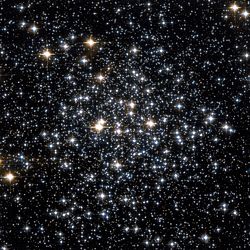- Messier 71
-
Messier 71 
M71 from Hubble Space Telescope; 3.35′ view
Credit: NASA/STScI/WikiSkyObservation data (J2000 epoch) Class X-XI Constellation Sagitta Right ascension 19h 53m 46.11s[1] Declination +18° 46′ 42.3″[1] Distance 12 kly[citation needed] (3.7 kpc) Apparent magnitude (V) +6.1[1] Apparent dimensions (V) 7′.2 Physical characteristics Radius 13 ly[2] Estimated age 9-10 Gyr Other designations M71, NGC 6838, GCl 115[1] See also: Globular cluster, List of globular clusters Messier 71 (also known as M71 or NGC 6838) is a globular cluster in the constellation Sagitta. It was discovered by Philippe Loys de Chéseaux in 1746 and included by Charles Messier in his catalog of comet-like objects in 1780. It was also noted by Koehler at Dresden around 1775.
M71 is at a distance of about 12,000 light years away from Earth and spans some 27 light years across. The irregular variable star Z Sagittae is a member of this cluster.
M71 was long thought (until the 1970s) to be a densely packed open cluster and was classified as such by leading astronomers in the field of star cluster research due to its lacking a dense central compression, and its stars having more "metals" than is usual for an ancient globular cluster; furthermore, it's lacking the RR Lyrae "cluster" variable stars that are common in most globulars. However, modern photometric photometry has detected a short "horizontal branch" in the H-R diagram of M71, which is characteristic of a globular cluster. The shortness of the branch explains the lacking of the RR Lyrae variables and is due to the globular's relatively young age of 9-10 billion years. The relative youth of this globular also explains the abundance of "metals" in its stars. Hence today, M71 is designated as a very loosely concentrated globular cluster, much like M68 in Hydra. M71 has a luminosity of around 13,200 suns.
References
- ^ a b c d "SIMBAD Astronomical Database". Results for NGC 6838. http://simbad.u-strasbg.fr/Simbad. Retrieved 2006-11-17.
- ^ distance × sin( diameter_angle / 2 ) = 13 ly. radius
External links
- Messier71 @ SEDS Messier pages
- Messier 71, Galactic Globular Clusters Database page
- Messier 71, LRGB CCD image based on two hours total exposure
- Messier 71 on WikiSky: DSS2, SDSS, GALEX, IRAS, Hydrogen α, X-Ray, Astrophoto, Sky Map, Articles and images
- Messier 71: an Unusual Globular Cluster, ESA\Hubble picture of the week.
Messier objects List M1 · M2 · M3 · M4 · M5 · M6 · M7 · M8 · M9 · M10 · M11 · M12 · M13 · M14 · M15 · M16 · M17 · M18 · M19 · M20 · M21 · M22 · M23 · M24 · M25 · M26 · M27 · M28 · M29 · M30 · M31 · M32 · M33 · M34 · M35 · M36 · M37 · M38 · M39 · M40 · M41 · M42 · M43 · M44 · M45 · M46 · M47 · M48 · M49 · M50 · M51 · M52 · M53 · M54 · M55 · M56 · M57 · M58 · M59 · M60 · M61 · M62 · M63 · M64 · M65 · M66 · M67 · M68 · M69 · M70 · M71 · M72 · M73 · M74 · M75 · M76 · M77 · M78 · M79 · M80 · M81 · M82 · M83 · M84 · M85 · M86 · M87 · M88 · M89 · M90 · M91 · M92 · M93 · M94 · M95 · M96 · M97 · M98 · M99 · M100 · M101 · M102 · M103 · M104 · M105 · M106 · M107 · M108 · M109 · M110See also  Book:Messier objects ·
Book:Messier objects ·  Category:Messier objects
Category:Messier objects  Portal:Astronomy
Portal:AstronomyCoordinates:
 19h 53m 46.11s, +18° 46′ 42.3″Categories:
19h 53m 46.11s, +18° 46′ 42.3″Categories:- Globular clusters
- Sagitta constellation
- Messier objects
- NGC objects
- Star cluster stubs
Wikimedia Foundation. 2010.
